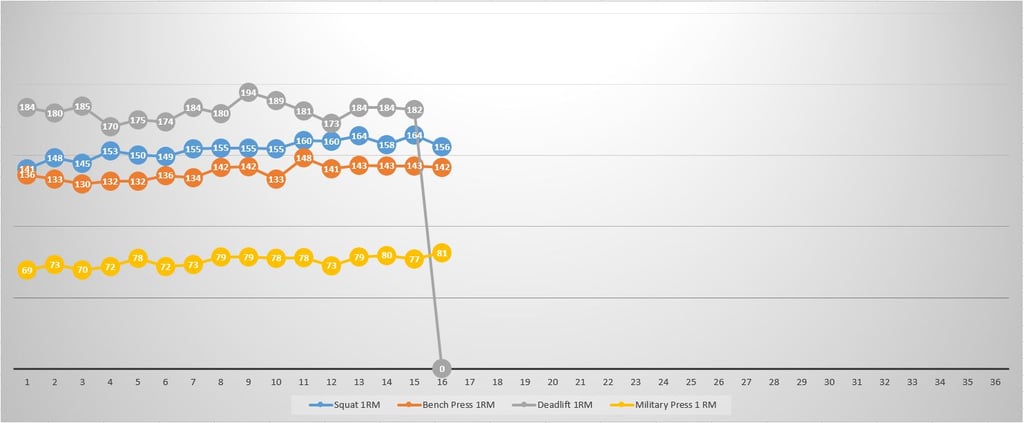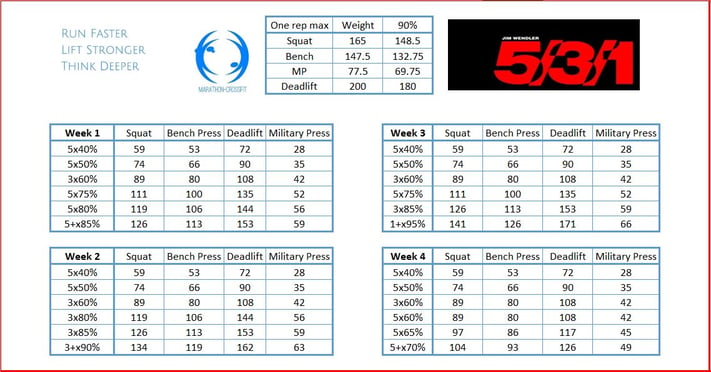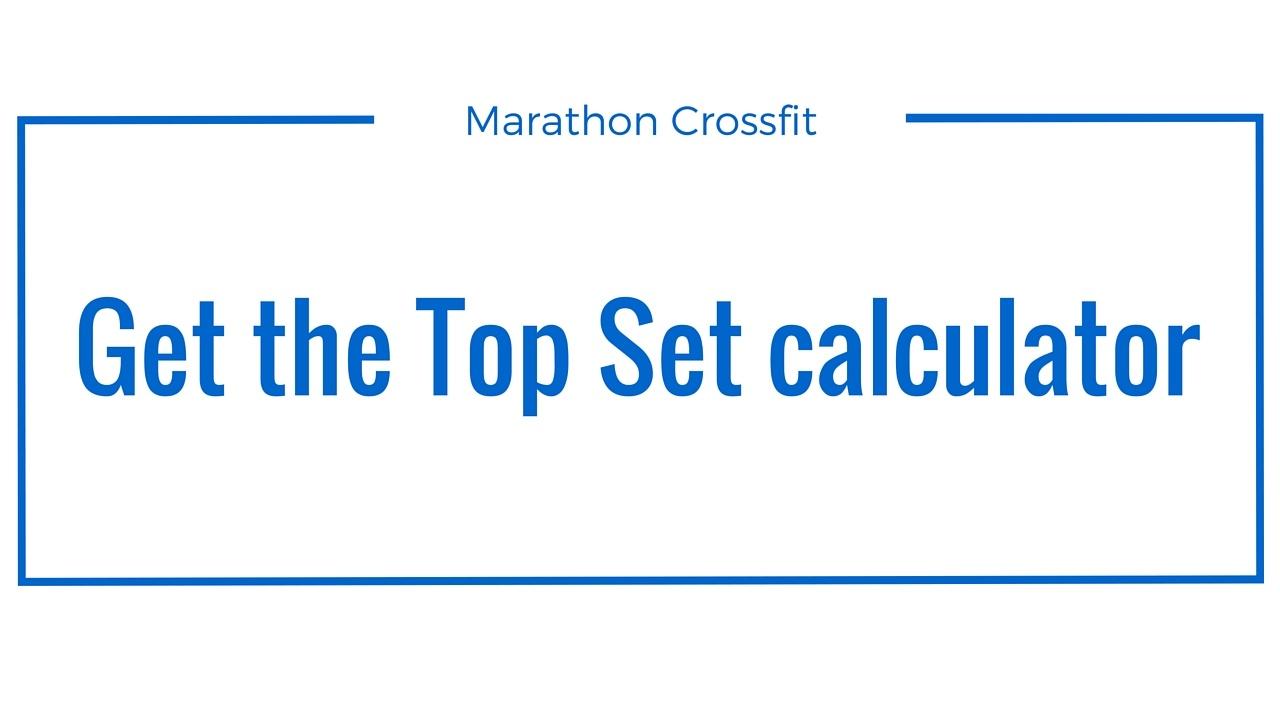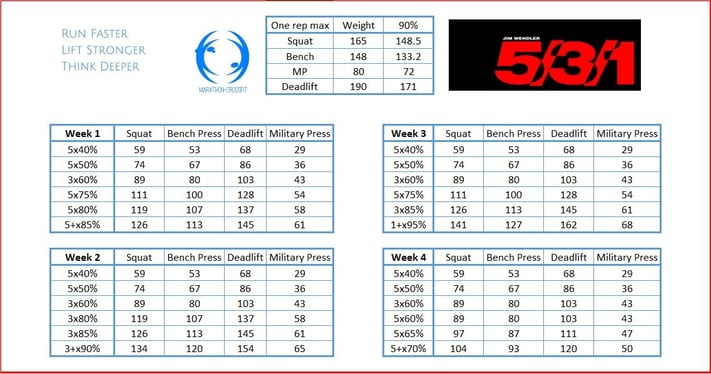How to reset Jim Wendler 531 when you stall
This is my take on how to reset and adjust on Jim Wendler. When you see the symptoms of a stall, act. When you act decide whether you want to be general or specific in your approach. You have to be general if you have no clear goal and plan. You should be specific in the adjustment if you have the data and knowledge to see the big picture and take the correct conclusions from it.
If you want the most up-to-date news or ask direct questions, then you can follow me on Instagram.
How to see that you are stalling on 531
There are several symptoms that can show you on any program that you have to reset or change your approach a bit. I personally tend to reset too late, trying to push through pain and failures for too long. Others shy away from any pain or get an itch to switch at the first opportunity when thing do not go their way. The truth is to find the middle between the two that is relevant to you personally. The longer you train and the more experience you accumulate, the better you will get at finding that sweet spot and admitting shortcomings to yourself. Compared to my Stronglifts 5x5 experience I am adjusting earlier now and with more knowledge why I am picking this point to adjust.
Symptoms are:
- Overuse injuries like bursirtis, a slipped disk, knee injuries etc.
- Not progressing on your lifts for longer than three mesocycles
- Feeling drained, powerless, losing motivation
- Restlessness, feeling like you are going nowhere
- Not finishing your sets
The clearer your goals are, the easier it will be for you to see whether you are stalling or not. A clear goal and defined plan which breaks it into chunks per cycle will show you whether your training is going according to plan or not.
When I started out with Jim Wendler my main goal was to achieve a 200kg squat at a bodyweight of 80 - 85kg with the program. At that time my one repetition maximum was at 140kg. This meant I had a gap of 60kg to bridge. If you run the numbers using Wendler's principles you need roughly a year to add this amount to your squat, assuming you do not have to reset. I designed the spreadhsheet, the Jim Wendler Calculator, to have my progressions in front of me whenever I go to the gym, printed it, and started.
Some cynics amongst you might say "Pascal, why such a goal, it is of no use and hard to achieve." I would like to retort with Jonh F. Kennedy's Moon speech when the cold war was at its height and Kennedy realized that he needed better rocket engines and had to find a way on how to buy the public into the idea of spending millions on beating the Russians on that technology. Well, Kennedy made it about the moon, but i personally think it also might have been about the fact that the Russians could nuke the US from a further distance and therefore did not need to position their missiles as close to the US as they had in reverse to retaliate might also have been a factor.. Here is the speech from September 12th, 1962:
Back to lifting roughly half a year after I set the 200kg squat goal and a year after my last major injury which put me out of the gym for almost a month in February 2015 I am now (February 2016) experiencing some pretty hefty back pain. This is partly due to bad posture on the conventional deadlift but is also a result of me getting to the current limits of my body. Cycle over Cycle it got harder for me to get my top set goal for the respective session. The final straw that broke the camel's back (quite literally actually) was me having to stop last week mid-way through my deadlift sets. This meant that was the first time in half a year that I did not finish all of my sets.
So if you observe these symptoms or have similar challenges, like lifting with bad form most of the time, consider a reset sooner rather than later on 531 or any other program.If you are just a month into it might only be some adaptation pain so also do not go to the other extreme always jumping the gun if you experience only one of the symptoms described and only for a short period of time. That is only of course, if you are serious about getting stronger, otherwise, do not put you through all of the hassles ;).
Finally here is the graph of my Top Sets and how my calculated one repetition maximum progressed. Pay special attention to the drop of the grey line to zero,because I did not do my top set on that day. You can also follow this on my youtube channel if you want to see the hard work done in person.

How to determine your current one repetition maximum for reset
For your reset, you need to know your one-repetition maximum. Your one-rep max can be determined in two ways:
- Calculated lift
- Actual lift
Both are legitimate methods to determine your one-repetition maximum. It depends on your level and character which one you will pick.
To calculate your maximum with a formula involves less risk and also does not leave you drained to move on with your slightly adjusted program right away. The downside is, that this does leave some room for doubt if you actually improved and what your actual strength level is. Real-world strength for competition, making it on a team or any other real-world goal can only be shown by getting the weight up. Full stop.
I personally, therefore, think that a calculated one repetition maximum is more appropriate for more experienced lifters for the following reasons:
- They have more data to work with
- They have more experience around how calculated one repetition maximums relate to their real-world performance
- They will most likely already have planned for / anticipated a stall somewhere in their preparations for competition and therefore there is no need for real-world proof of strength when the plateau occurs
- They usually need a longer time to recover if they do a one-repetition max test
- They expose themselves to more risk if they fail a one-rep max as a bone is a bone and a ligament is a ligament likely to get smashed if you drop 300kg onto them than 100kg
Doing an actual one repetition maximum test to reset is more applicable to beginning lifters in my perspective for the following reasons
- Less risk of injury as less actual weight is moved
- Quicker recovery times for beginners
- More variance in progression between good and bad days
- For beginners it is good to gain experience with heavy weights so that they will have the needed respect once they are intermediate lifters, otherwise, this might lead to nasty scenarios down the line when that healthy respect is not established early on
- They will most likely not compete and it won't be as bad for them to miss a competition as for more seasoned athletes
How to reset 5/3/1
Once your one-repetition maximum is established you again have two choices you can make on how to reset
- Reset all lifts to 90% of that max
- Select specific lifts to reset rather than all
In the first variation, you take on Jim Wendler's advice from his books and just simply reset all the lifts
- Squat
- Deadlift
- Overhead press
- Bench Press
to 90%. Simple, easy, no brainer for everyone, and proven to work. If you are more advanced and also wanted to put some thought into it you can adjust just specific lifts based on your feel and progression. Again here it is good if you have kept track somewhere of all the lifts you did. This will help you to make specific choices per lift whether to adjust or not. The biggest flaw of Jim Wendler 5/3/1 is that it is a "Cookie cutter" program. This means that it has been generalized to be easier marketed to a big crowd of people without accomodating to specific differences. A simple adjustment based on your specific therefore address this shortcoming already to some degree.
In my personal case, I feel pretty good about my squat and that is the main lift I want to improve. I went into the 531 workout experience with my deadlift and bench press being ahead of lifting level compared to a broader database compared to my squat. If I close that gap and get all main lifts on the same level, I have achieved one of my subgoals.
Also, the back pain I am experiencing is not as bad on the squat as on the deadlift. So all in all i decided to just go slightly down on the squat.
For the overhead press, I already entered the program with a very conservative one repetition maximum assumption of 65kg. This was due to the fact that the last overhead press I had done when starting was half a year ago. I am happy with my performance on the OH and therefore decided to not adjust at all and keep pushing forward, as also there is no pain when performing the lift.
For the bench press I also decided to deload based on my past performance, but not because I am experiencing pain and breakdown for my upper body, but because my top sets have been stalling and lagging and I felt I am not getting enough load in.
Finally, the biggest drop with 10kg is applied to the deadlift. This was the lift I was always happiest with and I got the most joy out of. At the moment it causes the most pain and needs the most fixing form-wise. I might even switch to Sumo deadlifts to attack other parts of my back and bring my deadlift on a broader strength base.
So these are some thoughts on how you can make Jim Wendler 5/3/1 more specific to you during a deload by applying some research on your numbers and thought, rather than just generally deloading on all lifts. Both methods have their merits depending on your lifting style. First approach would more align with Wendler's first publications, whereas working with variations and more specificity would more align with his Beyond 531 ebook.
Here are the examples for which adjustments I made from cycle 6 to 7 being on the program.
Note
No increase in one-rep max on squat
Only 0.5kg increase on the bench rather than 2.5
Kept progression on OH
Deloaded 10kg on deadlift

Conclusion
Have a goal, keep track of your progression, identify when you are stalling and do a root cause analysis. From there pick the right options depending on your experience and style to adjust. The less experienced you are the simpler the method of adjustment has to be. The more experience and data points you have the more sophisticated and targeted the adjustment can be inflicted. This post should give you ideas around what can work for you. If you find a gap or a specific challenge not covered please leave a comment so that I can steadily improve this article. If you would like to be referenced; I will gladly do so, if your contribution adds value.
Further reading
- 30. Jim Wendler quotes that kick ass
- Avoid the biggest mistakes with Jim Wendler 531
- German Volume Training vs Jim Wendler 531
- How to combine Jim Wendler 531 and the westside method
- Jim Wendler 531 Joker vs Volume Sets
- Jim Wendler 531 Bodyweight Accessory work
- Jim Wendler diet
- My second Jim Wendler 531 cycle
- Wendler 531 6 month review
- Wendler 531 for athletes
- Wendler 531 for beginners
- Wendler 531 for crossfit
- Wendler 531 for mass
- Wendler 531 for mma
- Wendler 531 should you train to failure
- Wendler 531 speed up techniques
- Wendler 531 vs Stronglifts 5x5
- Which Wendler 531 book should I read




